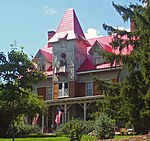Oliver Brewster House
Cornwall, New YorkGothic Revival architecture in New York (state)Houses completed in 1850Houses in Orange County, New YorkHouses on the National Register of Historic Places in New York (state) ... and 1 more
National Register of Historic Places in Orange County, New York

The Oliver Brewster House is a Gothic Revival home located on Willow Avenue in Cornwall, New York, United States, right across from Willow Avenue Elementary School. It was originally built as a farmhouse in the mid-19th century. Later, as Cornwall became a popular summer resort for visitors from New York City, it was expanded and renovated for use as a boardinghouse as well.
Excerpt from the Wikipedia article Oliver Brewster House (License: CC BY-SA 3.0, Authors, Images).Oliver Brewster House
Willow Avenue, Town of Cornwall
Geographical coordinates (GPS) Address Nearby Places Show on map
Geographical coordinates (GPS)
| Latitude | Longitude |
|---|---|
| N 41.438888888889 ° | E -74.037222222222 ° |
Address
Willow Avenue Elementary School
Willow Avenue 67
12518 Town of Cornwall
New York, United States
Open on Google Maps









